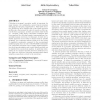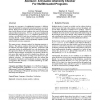96 search results - page 9 / 20 » Detecting Data Races in Sequential Programs with DIOTA |
PPOPP
2003
ACM
14 years 1 months ago
2003
ACM
Collecting a program’s execution profile is important for many reasons: code optimization, memory layout, program debugging and program comprehension. Path based execution pro�...
POPL
2004
ACM
14 years 8 months ago
2004
ACM
Ensuring the correctness of multithreaded programs is difficult, due to the potential for unexpected interactions between concurrent threads. Much previous work has focused on det...
CONCURRENCY
2004
2004
User transparency: a fully sequential programming model for efficient data parallel image processing
13 years 7 months ago
Although many image processing applications are ideally suited for parallel implementation, most researchers in imaging do not benefit from high performance computing on a daily b...
MEMOCODE
2008
IEEE
14 years 2 months ago
2008
IEEE
Concurrent programming languages are becoming mandatory with the advent of multi-core processors. Two major concerns in any concurrent program are data races and deadlocks. Each a...
SPIN
2000
Springer
13 years 11 months ago
2000
Springer
This paper describes how two runtime analysis algorithms, an existing data race detection algorithm and a new deadlock detection algorithm, have been implemented to analyze Java pr...


